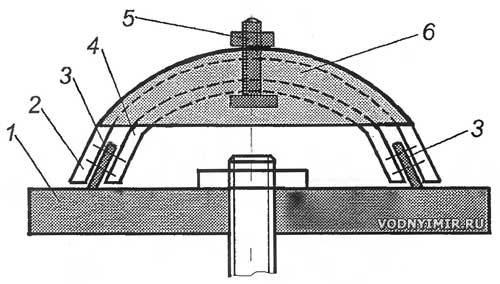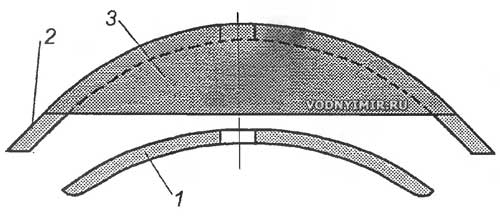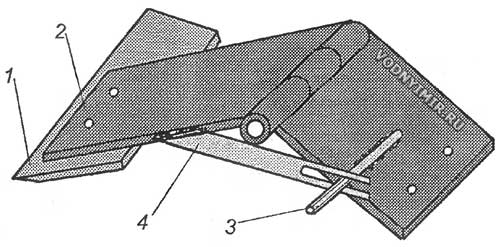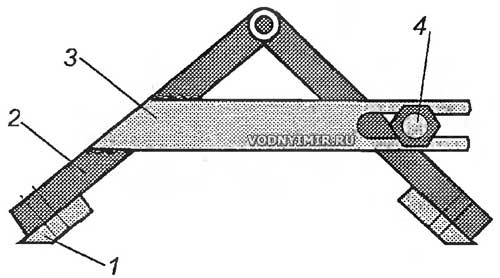How to properly sharpen ice drill knives. Device for sharpening ice drill knives
How to properly sharpen ice drill knives
In order to pull a fish out of a frozen pond in winter, you need to have a good ice drill with sharp knives. You can, of course, do with a grandfather's foot, but with ice more than 40 thick 60 cm ice drill is still better.
On lakes, ice pick knives remain sharp for quite a long time. But on rivers like the Akhtuba and especially the Volga, where there is a lot of alluvial sand in the ice, knives are blunt instantly. We have to change 2...3 pairs of knives per day. In short, it is necessary to sharpen knives for an ice drill after every fishing trip on the river.
It is known that when sharpening knives «by eye», blades are often obtained with some defects. Thus, the sharpened chamfer of the cutting edge is often skewed (Fig. 1).
 Fig. 1. Chamfer misalignment of the cutting edge (sharpening defect). |
It happens that the sharpened chamfer becomes oval, or with a break (Fig. 2).
 Fig. 2. Oval chamfer (a) and chamfer with a break (sharpening defects). |
Another sharpening defect is the formation of a burr directed towards the chamfer of the cutting edge (Fig. 3).
 Fig. 3. «Incorrect» burr (sharpening defect). |
Although, in general, a slight burr is allowed, oriented in the opposite direction. I will note that both those and other burrs are eliminated when finishing knives on a fine-grained bar with a flat surface or on a sheet of sandpaper (zero) spread out on a flat surface, for example, on a sheet of glass. Well, it is necessary to maintain the desired (optimal) angle of the cutting chamfer when sharpening knives (Fig. 4).
 Fig. 4. When sharpening, it is necessary to maintain the existing (optimal) sharpening angle of the blade: a — before sharpening; b — after sharpening. |
It is clear that all the defects listed above, as a rule, greatly worsen the cutting characteristics of knives. But it is equally important when sharpening knives by any method to prevent the darkening of the metal, that is, its overheating (burnout). And in order to prevent burnout, during the sharpening process, knives cannot be pressed against the grindstone with great effort, and they are also periodically cooled by dropping into cold water.
Check the quality of sharpening knives in the following simple way. Rest the blade of the knife against the nail of the finger, placing the knife chamfer up and at an angle of 20...30° to the nail. If the knife cuts into the nail with a light press, it means that you will not have to sweat when drilling holes in the ice. If the knife starts sliding on the nail, it's blunt. With the help of a nail, the sharpness of the knife is checked along the entire length of the cutting edge.
As already mentioned, sharpening knives «by eye» often does not give a good result. Therefore, I have designed a special device for this purpose, which allows to reduce possible sharpening defects to a minimum. And below I will tell you in detail about it.
Device for sharpening ice drill knives
The order of manufacturing the device for sharpening ice drill knives is as follows (the general view of the device is shown in Fig. 5). For such a device, two pieces of steel strip 3...4 mm thick, 50 mm wide will be needed 60 mm and 160 mm long 200 mm. You can use a piece of a car spring as a strip, but it will be difficult to bend it to the desired profile.
 Fig. 5. General view of the device for sharpening ice drill knives: 1 — emery wheel; 2 — body arc; 3 — knife; 4 — pressure plate; 5 — bolt with nut; 6 — stiffener. |
First, we make the body of the device by bending steel strips in the form of arcs so that the chamfers of the knives, tightly pressed to the ends of the arc, are not only parallel to each other, but also in the same plane. Then, when these knives are simultaneously sharpened on the end side of the emery wheel, the blades of the knives will acquire the same sharpening angles (see Fig. 5). Knives for the Leningrad ice drill in the device should be positioned at an angle β=115°.
Having made the arc of the device body, we bend the pressure plate from the same strip, with which we will fix the sharpened knives on the arc of the body (Fig. 6).
 Fig. 6. Design of the device clamping device: 1 — pressure plate; 2 — body arc; 3 — stiffener. |
After that, we drill in the housing and in the pressure plate along the hole for the bolt M12...M14. Then, pulling the housing and the pressure plate together with a bolt and nut, we clamp the knives between them (see Fig. 5) and check the accuracy of the fit of the knives to the end surface of the emery wheel. If the knives are not positioned at the right angle (there is no exact fit of the chamfers to the emery wheel), the device is brought to mind by bending the body arc accordingly. If the knives are installed correctly and no fitting is required, the structure is disassembled and stiffeners are welded to the body arc from both sides (see Fig. 5). Please note that the pressure plate should be 0.5...1 mm narrower than the body arc, so that when clamping the knives it does not cling to the stiffeners. That's it, the device is ready.
It is more convenient to sharpen knives on an emery stone rotating in a horizontal plane. In this case, after wetting the knives with water, the latter stays longer on the knives and the stone, ensuring the cooling of the knives and the safety of the stone. Lower the knives into the water more often during sharpening, which will help avoid overheating (burnout) of the steel.
The disadvantage of the device shown in Fig. 5 is the inability to sharpen knives with different angles of the cutting chamfer. But every manufacturer offers its own options, although it seems to me that Leningrad is the best. Therefore, it is necessary to make your own device for each type of knife.But you can also make a universal device. This is exactly the design proposed to us by A. Semenchenko — our colleague, a fisherman, a veteran ice fishing on Akhtuba and Volga. The proposed design of the device, shown in Fig. 7, allows you to sharpen knives with any angle of sharpening the cutting edge. By smoothly changing the angle between the shoulders of the device on which the knives are fixed with screws, you can fix the desired position of the knives relative to the plane of the emery stone.
 Fig. 7. General view of the universal device for sharpening knives at any angle: 1 — knife; 2 — canopy card with holes for fixing the knife; 3 — bolt fixing one or another angle between the cards (knives); 4 — fixing bar. |
To manufacture this version of the device, you will have to find a suitable door canopy (it is better that it be with minimal backlash), as well as an M8...M10 screw with a nut. In the shoulders (cards) of the canopy, holes with a diameter of 6...7 mm are drilled to attach knives to them with screws (of course, there must be corresponding holes in the knives). A fixing plate with a slot for the fastening screw is made of a 2...3 mm thick steel strip. Both the plate and the screw are welded to the canopy cards, as shown in Fig. 8. The device for sharpening ice drill knives with certain angles of the cutting chamfer is ready.
 Fig. 8. The design of a universal device for sharpening ice drill knives: 1 — knife; 2 — canopy card; 3 — fixing bar; 4 — fixing bolt. |
It may happen that you will have to sharpen knives in which the location of the holes for their attachment on the canopy does not correspond to the location of the holes intended for this purpose in the canopy. Then it is necessary to drill additional holes in the shoulders of the canopy corresponding to the mounting holes of «non-standard knives». And then the device will become even more versatile. To make the device more rigid, fixing plates and screws can be welded on both sides of the canopy.
We wish the fishermen good luck both in summer and in winter.
Share this page in the social. networks or bookmark:
